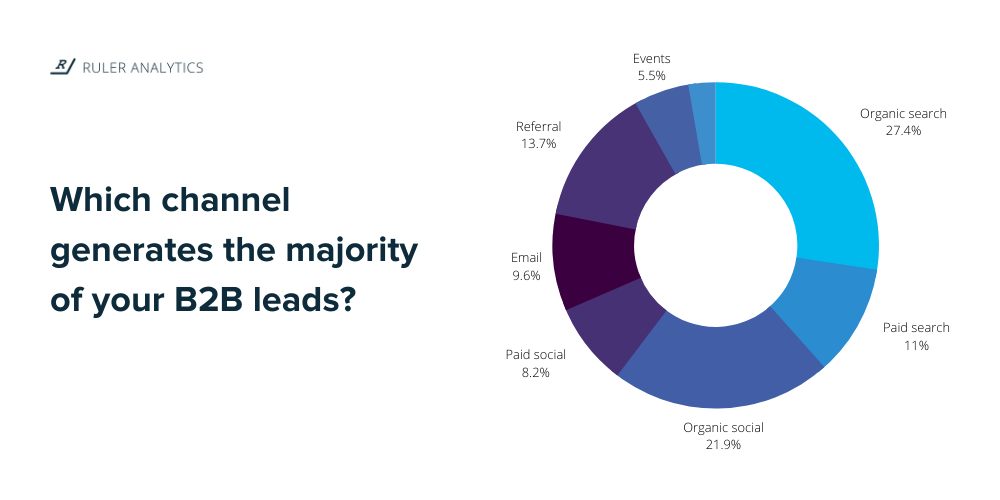Social media plays an increasing role in all our lives, not just from a personal perspective but also in the ways we do business and the ways we connect with customers, clients, suppliers, and so on. In fact, the number of people using social media is expected to reach some 4.41 billion by 2025.
Getting your B2B social media strategy right is crucial if you want to see effective results and a good ROI. However, getting that strategy right means you have to know what platforms to focus on and how to get the most out of the content you publish.
Image Source: 99 Firms
So how do you build a social media marketing strategy that will see an improvement in the results and KPIs that matter most to you? Let’s explore the B2B market and look at some guidance for you to consider.
The B2B Market
Image Source: 99 Firms
Before thinking about your social media marketing strategy, it helps to have some idea of the market you are looking at and some important and relevant statistics:
- 23.6% of US businesses are operating in the B2B market.
- 25% of marketing agencies utilize social media as their main focus for increasing brand awareness.
- 89% of B2B organizations use LinkedIn to generate leads (with assistance from tools like Linked Helper).
- 75% of organizations use LinkedIn for content marketing.
- 95% of B2B companies have dedicated budgets for content production.
- 42% of businesses attract new clients via Facebook.
So, the importance of social media to B2B marketing cannot be understated. If you were starting from scratch, how would you create a successful social media strategy for your B2B business?
7 Tips for a Great B2B Social Media Marketing Strategy
Image Source: Ruler Analytics
1. Choose Your Platforms Carefully
First off, there is little point in simply adopting every social media platform to market on and publish content on. You need to spend some time looking at where you will be able to find potential customers and generate leads and sales from. A good starting point for this is to look at what platforms your existing customers are using.
When it comes to B2B marketing, the most effective platform is LinkedIn. It is seen as a ‘professional’ network and you are more likely to find c-suite executives there than on, for example. Instagram. After Linkedin, B2B performs strongly on Twitter and, to an extent, Facebook, though the latter is best exploited via dedicated groups and pages.
YouTube should not be overlooked if you plan on a large amount of video content such as product guides. However, it is perhaps better to have your own channel on YouTube but embed or post any videos on the social media platforms you have chosen. For example, you could create a video on the benefits of a cloud phone service but then publish it on multiple platforms.
2. Decide How to Measure Success
As with any area of business, KPIs are how you measure success. When you formulate your social media marketing strategy, you need to decide how you will measure success on each platform you engage with customers on. You also need to decide appropriate timeframes across which you will measure those KPIs.
For example, you may want to look at ideas similar to this:
- A Twitter campaign gaining your account 500 new followers in a 2-month period.
- Content published on LinkedIn showing a certain level of engagement via likes, shares, or comments.
- Facebook content leading to increased engagement or more followers in a 30-day period.
- Increased leads and/or sales as a result of content published on social media platforms.
- Measuring if content can improve website traffic across a set period.
Setting out your aims and KPIs will not only allow you to create a new strategy, it will also offer benchmarks so that you can make any required changes as you move forward with campaigns.
3. Choose a Way of Tracking Your Chosen KPIs
Image: DivvyHQ Social Dashboard
Now that you have chosen how you will measure success, you also need a way of tracking those measurements. Being able to access high-quality analytics can give you an at-a-glance way of seeing how well your strategy is performing. There are a wide range of social media analytics tools now available, and which you choose will depend on preference and budget.
Being able to track engagement metrics is essential when it comes to moving forward with any strategy. Google Analytics will show what platforms are driving customers to your website and you can set goals for each campaign for it to track. Alternatives to GA include HubSpot Social which has the advantage of monitoring social media mentions of your brand and can track the performance of different campaigns across the different platforms you are using.
4. Optimize Your Social Media Profiles
You want new or potential customers to not only engage with posts, but to follow you for more content and updates and to, eventually, connect with you as a qualified lead. If you have an incomplete or substandard profile, then they will be less likely to take that initial step. That means you need to ensure that all your social media profiles are optimized and looking good.
Go through each of your social media profiles carefully. Make sure each one features your company logo and branding and that any bio/about section is fully completed. It is also essential that each profile has links to your site or primary landing page. After all, you want customers to see everything you have to offer and why they should choose you over your competitors.
5. What Are Other B2B Businesses Doing?
This is not just about looking at what your competitors are doing, though that is a large part of it. What it comes down to is the simple question of ‘what works for other B2B businesses?’ You can, however, start with the organizations you see as your closest competitors. What works for them? What platforms are they on and what content are they posting? What types of media are they posting and what is the split between paid and organic ads?
This info can lead to a good social media competitive analysis for you and your team to analyze. But you can also look beyond competitors at the businesses who are really successful in their social media marketing. Adapting ideas from the big players in the B2B market could give you an extra edge when it comes to outperforming the competition.
6. Create Great Content
The cornerstone of any good customer engagement strategy is great content and there is no one-size-fits-all approach to this tactic. You are going to have to create content that not only fits with the platforms you publish on, but also recognizes that the customer may be at different stages of the decision-making journey. Consider the following:
- Create content that corresponds to different buyer personas.
- Use a mix of original multimedia content but also some recycled content (you can present the latter in different formats).
- Have content that represents different stages of your sales funnel. Bottom of funnel content could include a demo video and top of funnel content could include blogs or research.
- Have a mix of original content created in-house and guest blog or articles. Having some outsourced content means you can include backlinks as will any guest writers. There is no set rule for ratios but a minimum of 50-50 is a good start.
- Look at whether involving an influencer on social media could boost results.
- Stay topical by featuring industry news and topics. People like to read about new developments rather than old news.
- Show your personality. People want to know the faces behind the words. You could post bios of team and company members of a behind the scenes look at how your business operates.
- Get your timings right. Optimum times for publishing content can vary from platform to platform. Research when it works best as well as experimenting to see what times your content gets the best engagement levels. You should be looking at posting daily depending on the platform.
7. Publish, Measure, Adjust
It may well be the case that you don’t get things right the first time. You have already decided on how you will measure any success and what period you are measuring over. Once ready, publish the content you have planned and monitor its effectiveness.
You can access analytics data as often as you want and can decide to make adjustments (if needed) before the chosen time period has elapsed. There is little point in allowing a campaign to carry on for 2 months if the first three weeks show really poor results. In fact, by adjusting things halfway through a campaign, you get access to good comparative data.
The Takeaway
Marketing strategies have evolved a lot over the last ten years. There is an increased amount of technologies that can help and you will often find yourself having to choose between multiple platform options.
Deciding on a strategy that will work for you may well be a case of trial and error. Choosing how you will create and publish your content may even involve a high degree of content automation. Don’t be put off if initial results are less than you expected; just look at what isn’t working and make the changes needed till you have a successful B2B social media marketing strategy.
For more great tips, tricks, and how-tos like this, subscribe to the DivvyHQ blog today.




